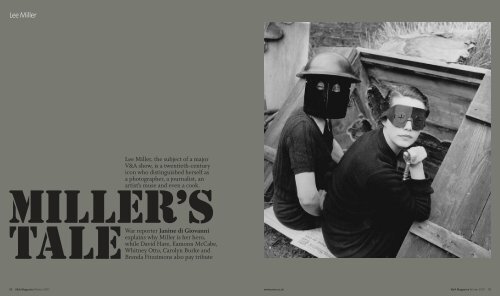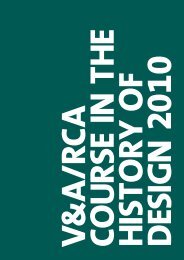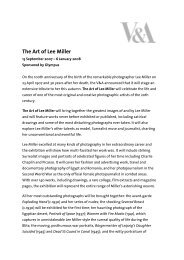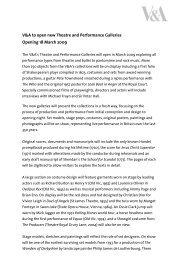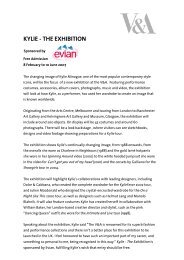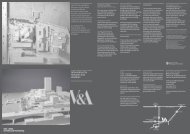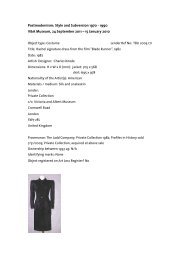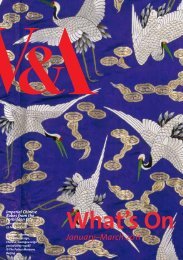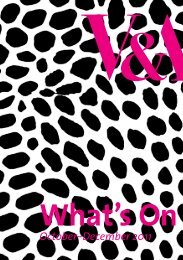VA14_Miller vAF
VA14_Miller vAF
VA14_Miller vAF
You also want an ePaper? Increase the reach of your titles
YUMPU automatically turns print PDFs into web optimized ePapers that Google loves.
Lee <strong>Miller</strong>Lee <strong>Miller</strong>, the subject of a majorV&A show, is a twentieth-centuryicon who distinguished herself asa photographer, a journalist, anartist’s muse and even a cook.MILLER’STALEWar reporter Janine di Giovanniexplains why <strong>Miller</strong> is her hero,while David Hare, Eamonn McCabe,Whitney Otto, Carolyn Burke andBrenda Fitzsimons also pay tribute50V&A Magazine Winter 2007 www.vam.ac.ukV&A Magazine Winter 2007 51
Lee <strong>Miller</strong>I first learned of the art of Lee <strong>Miller</strong> in 1985, shortly after herson Antony Penrose published his biography of her, The Livesof Lee <strong>Miller</strong>. I was still a student at the time, but I wascaptivated by this extraordinary woman who at differentchapters of her life was an artist, a muse, a photographer ofwar, fashion and portraits and a gourmet cook. She wastumultuous and complicated, but the message that I got wasthis was a woman who had truly lived her life to the fullest. Iwanted to be like her.What inspired me most were her photographs of the Alliedinvasion, which she followed in 1944-1945, and later herhaunting documentation of the aftermath of war. Lee’sstrength as a photographer was her ability to capture thesuffering of ordinary people in wartime, and the effect ofconflict on civil society.It was something unusual, but something vital: the humancost of war. Three years later, when I began my career as ajournalist reporting war and conflict, first in the West Bankand Gaza, later in the Balkans, Africa and the Middle East, Iwould often think of her photographs and how they touchedme. I wanted my words to have the same power, the sameimpact, that her pictures did.Infiltrating a macho man’s worldI was also inspired by her courage, and the way that she, abeautiful woman, infiltrated the macho man’s world of the warphotographer. And Lee <strong>Miller</strong> was a stoically brave warphotographer. She endured bombing raids and night patrols,which I would also experience years later in Bosnia, Kosovo,Afghanistan and other dark places. She never hung back. Toget her shots, she got close, so close that you imagine shecould smell and taste death.The photo of the Burgermeister of Leipzig’s dead daughter,her face caught in the final agony of suicide, her mouthhanging open, is one of Lee’s most gripping. But so are herpictures of the “dog faced infantrymen” that she lived with. Orthe shots of Londoners in the Blitz with their gas masks. WhenI thought of those photos, it helped me during the many yearsI spent reporting war to look closer, to look harder.But one of her most powerful photographs was taken in aViennese hospital in 1945. It is the portrait of a dying child,starved of medication, lying in a bed with perfectly starchedsheets. What disturbed Lee the most was that the hospital wasfantastically equipped with everything but medicine. Shestood by the bedside of the child along with a nun andhelplessly witnessed the end of life. “Last night I watched achild die,” she would later scribble in her notebook, slashingout sentences, and re-working them for the powerful dispatchshe would later file to British Vogue, with angry pencil marks.Like all great war photographers, she worked with a sense ofdetachment or an “ice chip in her heart”, says Mark Haworth-Booth, curator of the V&A exhibition ‘The Art of Lee <strong>Miller</strong>’.But in this case, that single moment of tragedy of an unknownchild overtook her. The ice chip melted when she realised herown futility. Even though the war was possibly the high pointof her life and her career, she was disgusted by the forces ofevil that had brought on such destruction.The Viennese hospital is one of my favourite photographs,but it is one of her most painful. And there are many others.Lee was one of the most successful accredited warcorrespondents working in Normandy, liberated Paris andlater Austria and Germany. Along with her companion DaveScherman of Life magazine, she photographed quietly in thebackground, bunking in with the foot soldiers. She did not shyaway from the worst of war: the blood, the guts, the fear thathits you in the stomach when the guns are close.Disillusioned with lifeBut it was the aftermath of war, the shambles inflicted onsociety, that possibly left the deepest scar on Lee’s psyche. Thiswas also the most painful for me, as a reporter. Women,children, old people, who are too weak to run, are always theones who suffer most. As a reporter or photographer, we areoften left with tremendous guilt that we have survived andothers have not.“It left her very disillusioned with life,” notes AntonyPenrose. “The people she cared about – the gypsies ofRomania, for instance – were in terrible shape after the war.”So what we see is Lee taking a journey through the troubledlandscape, documenting the ruins of history in Romania, inCentral Europe, and, later, the return of the cultural life inParis.She was a technically brilliant photographer, equal to, if notbetter than, the later Don McCullin and Jim Natchwey, butwhat was equally brilliant was her shiny life. All of the womenwho reported in the theatre of war at that time werefascinating and bold, but <strong>Miller</strong> had an added dimension. Shewas beautiful. Her face was described as iconic. She was alsowitty and smart. “She was described as clever, unpretentiousand fun,” says Haworth-Booth. “Isn’t that what everyonewould want to be described as?”From model to Man Ray’s museLee had lived many lives before becoming a war correspondent.Born in Poughkeepsie, New York, in 1907, she was so lovelythat her father, Theodore, photographed her endlessly, clothedand unclothed. She became a model and It Girl, and caused ascandal when a photo of her taken by Steichen was used for aKotex ad without her permission. She fled to Paris.There she became the obsession and muse of Man Ray, andthe lover of Picasso and many others. She modelled, but alsobecame a photographer, developing the technique ofsolarisation along with Man Ray. As a portrait photographer,she used mainly available light, and her images of Paris andFrance in the 1930s are legendary. She was also a writer; herdispatches for Vogue during and after the war were beautifullycrafted. In 1956 she left journalism and turned her hand tocooking, perfecting her skills to cordon bleu standards.At Farley Farm, the East Sussex farmhouse she shared withRoland Penrose, the founder of the ICA, and her only childAntony, there are still boxes of her handwritten and typedrecipes and menu plans. She was mischievous in her efforts,once making ice cream from marshmallows and Coca-Cola toannoy the critic Cyril Connolly, who had told her thatAmerican food was dreary. She concocted Surrealist cuisine,such as meat loaf in gold leaf. Instead of returning todocument the conflict in Indochina as she had imagined shewould in 1946, she focused entirely on running the bohemiansalon as an avant-garde hostess. Her guests included oldfriends such as Man Ray, Picasso, Max Ernst and DorotheaTanning and figures in the London literary and art world.Most bizarrely, she kept the life she lived during the war –reporting the siege of St Malo, curling up in Eva Braun’s bed,having a bath in Hitler’s tub after having trawled through thekilling fields of Dachau and Buchenwalkd – a secret.Piecing together the <strong>Miller</strong> puzzleAfter her death, Antony began sifting through the cardboardboxes in the attic of Farley Farm looking for baby pictures ofhimself. Instead, his late wife Suzanna discovered a graphicdispatch Lee had written on her baby Hermes from the siegeof St Malo, describing the bombing and machine gun fire. Themore they searched, the more treasures they uncovered: hernotebooks, her Rolliflex negatives, her prints, her wool warcorrespondent’s uniform made in 1943 specially for her onSavile Row. For a son who had never know this side of hismother, it was a revelation.She had tried to settle into domestic life, but Antony feelsshe never got over the war, never forgot the child dying inVienna, or the piles of bodies in Dachau. Perhaps the act ofleaving her photography behind was an exorcism. Heremembers that while she was “handy with a camera”, henever knew the extent of her photographic career.Lee’s life ended sadly. As her extraordinary beauty faded, asthe memories became more obscure, she drank too much andsank into a darker place, brought on, possibly, by the horrorsshe had seen on the European battlefield. She died at the ageof 70 of pancreatic cancer, leaving behind her son to piecetogether the extraordinary puzzle of her life.Lee <strong>Miller</strong> remains fascinating to me and countless others.As Antony notes, his mother lived many lives, effortlesslymoving through each with grace and a steadfast determinationto change, to reinvent herself, to emerge a different character.She will always be one of my heroes. I would have liked tohave drunk a large whisky with her at her kitchen table inFarley Farm, or tasted the marshmallow ice cream with Coca-Cola. Or worked beside her when she photographed Hitler’ssecret apartment, or been with her as she witnessed the triagedoctors working in a war hospital with such grace andheroism. But instead, I have Lee’s photographs. They never failto inspire me.Farley Farm is open to visitors by appointment only:01825 872691; www.leemiller.co.uk‘The Art of Lee <strong>Miller</strong>’, sponsored by Olympus, V&A, LondonSW7 (020 7942 2000, www.vam.ac.uk), until 6 January.The V&A has a series of exciting talks and events toaccompany this exhibition. For further information visitwww.vam.ac.uk/activitiesandeventsPrevious pages:Women with FireMasks, DownshireHill, London, 1941.Facing page: Lee<strong>Miller</strong> and Pablo andPicasso – Liberationof Paris, 1944. Farleft: Burgermeister ofLeipzig’s DaughterSuicided, 1945. Left:‘Working Guests’:Saul Steinberg atFarley Farm, 1953. Allimages © Lee <strong>Miller</strong>Archives, England2007. All rightsreserved52V&A Magazine Winter 2007 www.vam.ac.ukV&A Magazine Winter 2007 53
Lee <strong>Miller</strong>Left: Nude Bent Forward, c.1930.Below right: Remington Silent,London, 1940“Magazine photographytoday is boring. There’sno thinking. Lee <strong>Miller</strong>thought – and it shows”David Hare,playwright and authorI like Lee <strong>Miller</strong> most of allthe Surrealists because she’sthe one who put thephilosophy to best use. A lotof men talked Surrealism, butshe lived it. She had thefortune to find a greatsubject – the Second WorldWar – where the randomnessof violence and the beauty ofdestruction could suddenlybe expressed by an eyetrained on more arcanesubjects in Paris in the 1920sand New York in the 1930s.She could compose a picturefar better than a regularnews photographer, butbecause she was alive to realtragedy, she could also givephotography a charge andimmediacy which a mere“art” photographer can neverreach. Magazinephotography today is boringbecause it celebrates nothingbut celebrity and wealth.There’s no thinking. Lee<strong>Miller</strong> thought – and itshows.54V&A Magazine Winter 2007 www.vam.ac.ukV&A Magazine Winter 2007 55
Lee <strong>Miller</strong>Left: Portrait of Space, frame 3,1937. Below right: Self-portrait inHeadband, published 1933Eamonn MCCabe,photographer and former picture editorof the GuardianLee <strong>Miller</strong> was the original superwoman.Beautiful, passionate, clever, greatphotographer, great cook and greatwriter. She was also incredibly brave. AsDon McCullin observed: “To have gonefrom being idolised and loved andturned into a beauty icon… to live in atrench, be shelled and live on tinnedfood with the fear of dying any moment– that shows real credibility andcourage.”I know her best as a wonderfulphotographer with a real sense of styleand wit. Her photograph of Women withFire Masks, taken during the war inLondon in 1941, is one of the mostperfect photographs I have ever seen. Itcombines documentary with fashion,shape, form and humour. Brilliant!And my idea of the perfectphotograph is one <strong>Miller</strong> took early inher career in 1932 in New York, and she isin it. It is the perfect self-portrait, withher sitting in a chair, brilliantly lit fromone side, dressed in a beautiful gownand a simple headband, but she doeslook thoughtful – did she know thenwhere her life might lead?Whitney Otto,author of How to make an Americanquilt (Ballantine)First, I fell in love with Lee <strong>Miller</strong>’s face.Before I was familiar with herphotographic work, it was Lee inpictures taken by Man Ray, Steichen,Genthe, Horst, Hoyningen-Huene thatcaught my attention. It was Man Ray’spainting of her lips, floating on canvas.While writers frequently borrow thelives of other people for their novels, it isLee’s physicality that inspires mycharacters. In this way, I “photograph”her with words. Her beauty isextraordinary because it isn’t limited toan elegant image. It’s easy to sense akind of shifting, unknowable aspect justbelow the surface, and so difficult tograsp its nature. Her face seduces anddisturbs.Then, one day, you stumble upon herphotographs, and suddenly it’s mucheasier to understand the allure of herface. It doesn’t matter if the picture is aself-portrait, or portrays other artists. Itcan be the “exploding hand” of a wellto-doParisian opening a glass door, or abroken church in wartime London, or theheartbreak and horror of theconcentration camps. It can be asummer picnic with friends in the Southof France. Or the empty expanse of theEgyptian desert in Portrait of Space(1938), a picture combining feelings ofenclosure and of an infinite landscape.Has there ever been a more succinctvisual statement of a life in flux?It is her Surrealist’s eye; her life thatbegan on an American farm and endedon an English one, and all thathappened in between. It’s the ease withwhich she could be both subject andphotographer, and the unease with thesecond half of her life. All of this isreflected in that gorgeous face, andthat’s why I write about her.56V&A Magazine Winter 2007 www.vam.ac.ukV&A Magazine Winter 2007 57
Lee <strong>Miller</strong>Brenda Fitzsimons,prize-winning first femalestaff photographer on theIrish TimesThank God for Lee <strong>Miller</strong>: sheis my key to a life lessordinary and a template to alife I still dream about. Shehad an incredible sense ofself which was nonnegotiable,and I always hada fascination for her. In all her“lives”, Lee lived them to thefull. She made me believeanything is possible, and Iprayed to her for guidance ata time when there werevirtually no femalephotographers in Ireland andfrankly my career guidanceteacher thought radiographywas more “womanly”.Her beauty, grace anddetermination combined tomake an extraordinary life ofsubstance. Not infrequently, Ineed to look at Lee’s work fornourishment, energy andinspiration. Behind theeffortless perfection of herpictures lies a silent witness,an unobtrusive observer, anartist. Very few femalephotographers have scaledthe heights of World PressPhotography, but she morethan punched above herweight in this mostcompetitive field ofphotojournalism. Thank you,Lee.Carolyn Burke,writer and author of Lee<strong>Miller</strong>: A Life (University ofChicago Press)I met Lee <strong>Miller</strong> monthsbefore her death in 1977. Wetalked of her life on bothsides of the camera, hermany loves and theexperiences that marked herprofoundly. She told me thatthe death camps of theSecond World War were stillwith her: “I could never getthe stench of Dachau out ofmy nostrils.” She also saidthat she had terminal cancer,which gave one perspective.Yet she hadn’t regretted amoment of her life andlooked to its end withcuriosity. This stance,meeting events as they comewithout preconceptions,impressed me deeply, at leastas much as her mesmerisinglooks and stunning artistictalent. It may be <strong>Miller</strong>’slegacy to the spirited womenof today who seek toemulate her, the reason whywe celebrate her centenaryas if she were still with us.For in many ways she is.“Lee miller made mebelieve anything ispossible, and I prayedto her for guidance”Above left: David E Scherman, Lee<strong>Miller</strong> in Hitler’s Bath, Munich,1945. Right: Dead SS Guard inCanal, Dachau, 194558V&A Magazine Winter 2007 www.vam.ac.ukV&A Magazine Winter 2007 59
Lee <strong>Miller</strong>Below: Bombs Bursting on theCite d’Aleth, St Malo, 1944. Right:Untitled (Exploding Hand), c.1930Ali Smith,Whitbread Prize-winningauthor of The Accidental(Penguin)One of the many things thatmake <strong>Miller</strong> such asuperlative artist is herability, or maybe herdetermination, to reveal thehuman spirit and the spiritthat’s in art as one and thesame. It’s something to dowith her understanding andparticular articulate use ofthe true natures of light anddark and their relation toartifice – whether in a pictureof Picasso lifting a canvas upto the sun, so that thesunlight and the verylightness and movement ofart come together, or thepicture of a silhouettedsinger poised in a bombedoutEuropean cathedral, herwar-tautness emphasised bythe music that’s coming outof her, right there in the darkruins of everything civilised.60V&A Magazine Winter 2007 www.vam.ac.ukV&A Magazine Winter 2007 61


